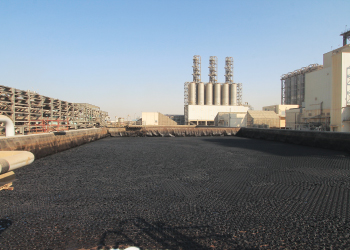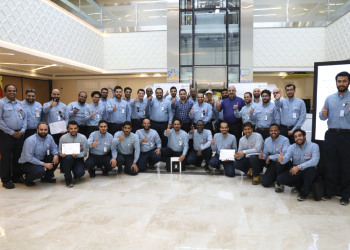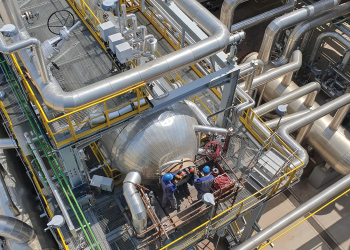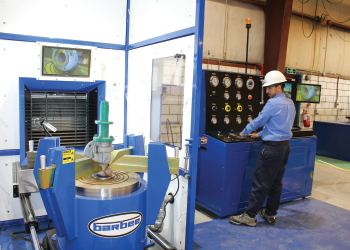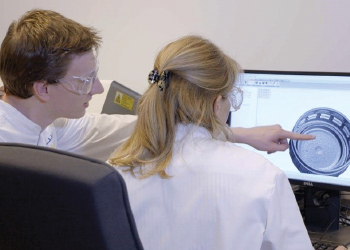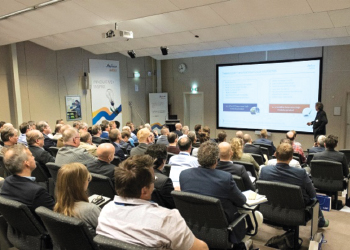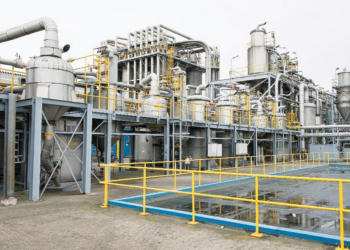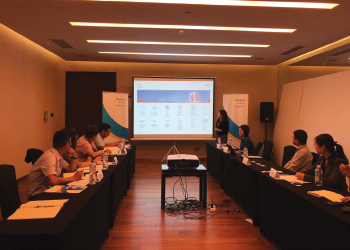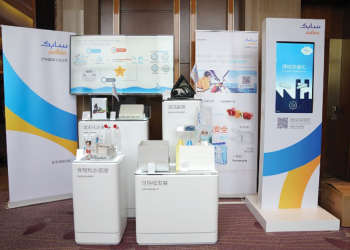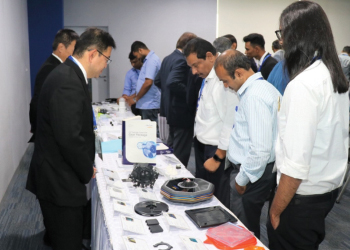
 The Ingress Group team (Left to Right) Douglas Cisneros, Al-Mutlaq, Nishantha and Asim Bukhari
The Ingress Group team (Left to Right) Douglas Cisneros, Al-Mutlaq, Nishantha and Asim Bukhari
Over the last two hundred years, buildings have become taller and the man-made world has created a vertical challenge, writes ABDULAZIZ AL-MUTLAQ, General Manager of Ingress Group
Ropes have been used by man for several thousand years. The first ‘ropes’ were natural vines that were used to swing from tree to tree. By pleating and joining plant fibres it was possible to make strong ropes that could be used to join, bind, pull and climb up. Without rope, the pyramids and Stonehenge could not have been built, boats could not have sailed, wells could not have been dug and simple mechanical devices such as the pulley would have been impossible, writes Abdulaziz Al-Mutlaq, General Manager of Ingress Group.
Before people could offer rope access services, they had to do it all without the rope, meaning your lifespan as a rigger would be measured entirely on your balance!
Like spiders, man was able to use rope to ascend and descend in order to access food and shelter or simply travel from one place to another. Modern-day examples of the early use of rope for access can be seen in various parts of the world. The honey hunters of Nepal descend sheer cliffs on ropes to harvest precious honey. In Thailand and Vietnam, agile climbers ascend ropes to collect the glutinous nests of swifts that are the main ingredient in bird’s nest soup.
 |
Rope access is the safest way to handle building maintenance |
On sailing ships, crew members are hauled aloft to effect repairs to the sails, rigging and masts. Over the last two hundred years, buildings have become taller and the man-made world has created a vertical challenge. Safety did not appear to be a concern in the early 1900s when construction workers operated without ropes or harnesses.
Mainly as a result of advances in mountaineering and abseiling, rope access techniques were used to position workers onto the outside of structures for cleaning, maintenance and repair. The offshore oil and gas industry operate in a hostile environment and works to high safety standards. Access to hard-to-get-at locations on the many offshore installations was a problem. Initially scaffolding or a crane and basket was used but this was both expensive and carried risk. It required a radical new approach and the industry called upon the expertise of climbers with ropes to reach these otherwise inaccessible spots.
The result was rope access companies being able to offer themselves out with the unique ability to climb the sides of buildings and work there, suspended with everything they need, at a greatly lowered risk of falling. Without the need for a background in rock climbing, more and more workmen could train to work at height, with high access jobs becoming more and more accessible as the technology advanced.
 |
Rope access is now a standard and cost-effective route to get the right skills and right equipment to where it is required |
Eventually this led to the foundation of IRATA (Industrial Rope Access Trade Association), created by the top rope access companies to help tackle rope access offshore such as oil rig maintenance. Over time, IRATA became known as a governing body, an authority in rope access who offer training and qualifications to high access workers, these qualifications which are now make-or-break for a rope-dangling technician. IRATA, the Industrial Rope Access Trade Association, was formed in the UK in the late 1980s, to solve maintenance problems in the offshore oil and gas industry. Its formation was the result of an initiative of a number of leading companies who had begun to use industrial rope access techniques, to provide a safe working environment for the industry.
The rope access technique developed by IRATA has now come to be used in a wide range of repair, maintenance, inspection and access work. Since it provides an unrivalled safety record, a quick set-up and dismantling time, positive environmental benefits and no need for invasive access equipment or disruption of the site, the IRATA system of rope access continues to enjoy increasing popularity throughout the world. IRATA is now recognised as the world’s leading authority on industrial rope access. It has over 200-member companies around the world and has trained in excess of 70,000 rope access technicians worldwide. The Association directs and manages through its members the training of all workers seeking its qualifications. These member companies provide training or operational services, or both.
As industry leaders, workers and experts we all know that the longer a job takes to complete, the more it costs the business. This may not directly correlate with the quote but more in the inconvenience. If a job takes a month because of scaffolding and other challenges, it becomes an obstruction for customers to get into the building. As a result, millions of dollars may be lost during the times that maintenance is taking place. When rope access companies are used, the technicians are on ropes safely anchored on the roof of the building. Rather than working from the ground up, they work from top to bottom. This means that there’s no interference for people on the ground level, so it’s business as usual. Rope access is the more cost-efficient way to handle building maintenance because there is simply less product and inconvenience and this is reflected in the bottom line of a quote. Instead, you save money and get a higher quality end result.
The ultimate goal is to avoid accidents and danger as much as humanly possible. To do this, a safe work system needs to be maintained at all times for workers, the property, passersby and the environment. According to IRATA’s Work and Safety Analysis 2017, in 2016, there was just one case of fatality reported while working at height using rope access equipment. In addition to this, there were just two major injuries. As a project director or facility manager, you can rest easy knowing that your project is unlikely to ever come to a standstill due to an accident. We won’t compare accident rates when using rope access equipment versus scaffolding directly, as they are measured differently. In fact, scaffolding statistics only account for the installation of the system, while rope access statistics account for installation and actual work.
Some of the few jobs that Rope Access Technicians can conduct while on the ropes are NDT, Blasting, Painting, Integrity checks and much more! Rope access is now a standard and cost-effective route to get the right skills and right equipment to where it is required. Long gone are the days of people taking their lives (and the lives of anyone beneath them) into their own hands. With an IRATA certified technician, you are assured that no matter how difficult the request, it is always carried out safely. For help at height, Ingress Group is the answer.










































































